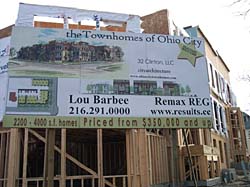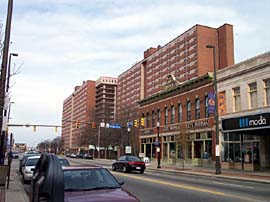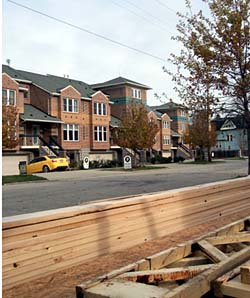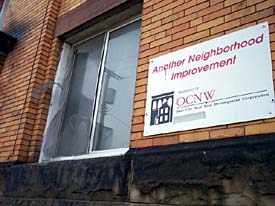


| Vol. 1, Issue 4 | |

|
By Marc Lefkowitz The way Ohio City Near West (OCNW) executive director Joe Mazzola sees it, the influx of high-end condos and town homes ranging from $300 - $700,000 in Ohio City is a dream. Middle- to upper-income suburbanites and empty nesters flocking here to snatch up the new units—keep them coming.
Lest we forget the brisk market for older homes—in some cases tiny worker cottages no larger than 1200 square feet—where boho urbanites are spending tens of thousands of dollars on upgrades and rehabs. From where Mazzola sits, it’s exactly what this long downtrodden, Near West side neighborhood needs. “There was a time not too long ago when you couldn’t give real estate away in Ohio City,“ Mazzola says. “Now, there are people who worry about half-million dollar condos interspersed with modest homes. "I see people coming back to the city and buying these homes and I say, ‘God bless ‘em.’” Luxury homes in Ohio City are one of the city’s bright success stories. It’s also a nightmare in the making for some long-time Ohio City residents who have worked for decades to create a “sustainable, economically diverse neighborhood,” in the words of one. The polarization between the two sides strikes some as reminiscent of our Red versus Blue political landscape. But, new housing starts and quickly rising resale valuations in Ohio City alone are not the problem, affordable housing advocates say. Rather, it’s OCNW’s recent change in policy—removing an historic emphasis on affordable housing from its mission statement—that has them worried, and wondering if Ohio City will go from runaway success to runaway train. “It’s painful to me,” says Mike Fiala, who has lived in Ohio City for 20 years and serves on a number of boards, including OCNW’s. “Historically, a CDC’s mission is to redevelop its neighborhood. “Investment in lower income people is one of best investments a CDC can make,” he adds. “It happened in my neighborhood. [CDCs] did a range of things, including fee simple purchases. People get stabilized in their housing, which helps develop job stability. It’s the foundation.” Fiala has helped housing advocates launch programs and cement deals with the local community development groups to ensure that people of modest means can afford to live and work in Ohio City. Yet he is quick to note the stabilizing force that residents with higher incomes can bring to a neighborhood like Ohio City. “I like the changes in my neighborhood,” Fiala says. “Some things on my street used to scare the daylights out of me…I also know people who have lived on the streets and they’re good people, too. The crucial question is whether one believes in sustainable economic diversity.” By most indications, the market’s answer has been, no, thanks. In the last decade, the sparkling redevelopment of Ohio City’s main commercial district at W. 25th and Lorain Avenue (funded predominantly with public money) led to private reinvestment in the storefront businesses and in neglected Victorian homes nearby. In turn, that jump started the speculative market of luxury housing. The adaptive reuse of the Fries & Schuele department store at W. 25th and a half-dozen new apartment and town home developments underway along Clinton and Franklin are either catalytic or signs of Ohio City’s gentrification, depending on whom you ask. Either way, when the majority of OCNW’s board voted to remove the emphasis on affordable housing this fall, it caused a stir. The move challenged perceptions that CDCs are the so-called 'developers of last resort'—building in neighborhoods where no bank or private developer dared. Yet, here was Ohio City admitting that it’s no longer in such desperate straits, prompting a new confidence and direction for OCNW.
“The low income housing component is here forever in [Cuyahoga Metropolitan Housing Authority developments] Riverview and Lakeview,” Mazzola says. “It seems like it would take a long time, if ever, before we’re dealing with a limited market. “We’re still seeing a significant number of homes bought for under $100,000, and yet I hear it’s hard to find an affordable home in Ohio City? If anything, higher income individuals are underrepresented. They raise everyone’s property values and when that happens, people who were losing are now making it back.” Ultimately, it appears that OCNW is turning a corner, or perhaps they, like many CDCs around town, are opting out of the business of developing affordable housing for other reasons. “I think CDCs could provide more value to those in need by focusing on economic development,” Mazzola says. “When an establishment opens up here, more jobs become available. They may not be steel jobs, but maybe it helps get people out of poverty.” In reality, most CDCs don’t have an affordable housing emphasis in their charter, says Meg Slifcak, assistant director at Detroit-Shoreway Community Development Organization. More importantly, they don’t have the resources to be in the business of developing affordable housing. “You need infrastructure to do it,” says Slifcak. “In the last three years, organizations have not been taking it on because it’s not generating income and they end up subsidizing it.” Detroit-Shoreway may be the exception: It’s one of the few CDCs in Cleveland with three property managers and three maintenance staffers to oversee its portfolio of 300 (and growing) affordable housing units. Slifcak says that CDCs are struggling to meet the huge demand for affordable housing. Hurdles include available land, two to three year turnaround time for projects, limited staff and financing. All told, costs overshadow lack of staff or will for CDCs, says Phil Star, Director of Cleveland State University’s Center for Neighborhood Development. “The difficulty is being able to acquire units that are not in good shape at a decent price so that, at the end, the rehab costs are not too high,” he says “If you have to spend $60,000 on a unit in Ohio City, you’re not going to be able to do it. It’s about resources and having appropriate programs.” Affordable housing begins and ends with the federal government’s Low Income Housing Tax Credit (LITC). Ohio receives $22 million in credits during a 10-year period, which generates $220 million in housing or some 40 to 50 projects, according to Slifcak. LITC covers about 60 percent of development; the rest is paid with bank debt and ‘soft debt’ (federal dollars that the city uses to offer forgivable second mortgages). In Ohio City, a boom in the private market has made acquisition costs and the environment for affordable housing much more challenging. “Some would say as long as Riverview and Lakeview Terrace are here, that you’ll never have a problem,” Fiala says. “I would say they present unique qualities because of their density, but I tend to focus on what’s happening in the neighborhood.”
In the neighborhood north of Lorain and east of W. 45th Street, Fiala says, steadily rising median home valuations are already in the range of $150-175,000. Stability from the influx of middle-income residents is the benefit of private market investment. But, it has some worried that rising property values are leading to higher taxes, which is disproportionately affecting those living in homes without tax abatements. Mazzola counters that a $10,000 rise in property value equals a $16 a month increase in taxes, and that isn’t enough to offset the gains in equity for long-time residents. Still, the relative stability is spurring policy makers such as Cleveland councilmen Mike Dolan and Matt Zone to introduce legislation that calls for a reduction in property tax abatements across the city. Mazzola agrees that reducing tax abatement may be coming, but adds, “it’s not the overriding issue. This is a poor city. Think about what it would be like without the 10,000 units of tax-abated properties that were built. The last thing the city wants to do is give up the taxes [but] that’s how desperate Cleveland is for investment.” Meanwhile, organizations formed to bridge the gap between the private market and affordable housing are at a crossroads. Some of these came into being after long-time residents of Ohio City witnessed slum landlords (and juvenile delinquents) torch their boarded-up buildings in the 1970s, which spurred them to get active in the neighborhood. Or, they came about when the area’s community development corporations Near West Housing Corporation, Stride for Pride and West Side Development Corporation merged. Out of the tumult emerged OCNW, which birthed two affordable housing groups—the West Side Rental Housing Collaborative and, more recently, The Cuyahoga Community Land Trust. A group of housing advocates in Ohio City, including board members of OCNW, formed The Cuyahoga Community Land Trust in 2000. The basic premise is anyone below 80 percent of the area’s median income can purchase a land trust home, but the trust maintains ownership of the land in order to keep the resale price from skyrocketing. The organization has an agreement with OCNW to produce 10 homes, but to date only three have been completed, with a fourth in the works. With the private market booming, though, it appears that OCNW’s desire to produce land trust homes in Ohio City has slackened. “We’re in a situation where we’re probably not going to do a lot more with OCNW,” land trust director Marge Misak acknowledges. “It becomes harder to create the affordable units when prices are taking off.” Misak, a former OCNW board member, says the change in the organization’s mission is a complete about-face from the goals stated in its Strategic Plan for 2001-2004. “OCNW acknowledged that the market was very strong and so market rate housing, especially on scattered sites, was being taken care of by the market. So, it made sense that their efforts should be on affordable housing and, specifically, on land trust housing.” Of the two prime directives for CDCs—serving underprivileged communities and creating economic opportunity – Misak says the former will suffer from OCNW’s new direction. “We have scarce resources in the city and the federal government is not helping," she says. "Those resources should be made available and remain available by creating permanent, affordable housing.”
At the same time, the demand for affordable housing has not slackened. According to a 2002 study conducted by Cleveland State University’s Levin College of Urban Affairs, 3,800 people are chronically homeless in Cuyahoga County, and another 28,000 to 30,000 are living on the fringe of homelessness or are ‘doubling up’ (living with others). The study also found that only 500 to 1000 units of housing are created per year in the city. While the supply of affordable housing in Ohio City apparently has reached its peak—with no new projects coming into the pipeline other than a renewal of two LITC projects (the Miller Building and the Clinton Building)— it is a priority in Detroit-Shoreway, says Slifcak. In addition to the $10 million Gordon Square project, the CDC is involved in conversions of at least four other affordable housing developments. It does have one joint venture in the pipeline with OCNW—a senior home at W. 32nd & Franklin that has 27 affordable and 13 market rate units. Also on tap for Detroit-Shoreway are consulting gigs for nearby land-rich CDCs, such as Stockyards and Clark-Metro, and large nonprofits such as Eden, which provides affordable housing for the mentally disabled. Detroit-Shoreway is partnering with Eden and Cleveland Housing Network in a deal for a 50-unit permanent affordable housing project at W. 78th & Madison. “It’s monumental that these two agencies are working together on a project of transformational scale,” Slifcak says. “We have Councilman Zone to thank for this because he led an unbelievable public process to get it done.” Meanwhile in Ohio City, success is not assured, Mazzola
says, even with the luxury condos piercing the skyline. “[Cleveland]
is a no-growth market. There’s a little bit of money out there
and we’re competing with everyone for it. How do we put ourselves
on a competitive advantage? We open the doors as wide as possible
to appropriate development.” |
“We’re still seeing a significant number of homes bought for under $100,000, and yet I hear it’s hard to find an affordable home in Ohio City?"
—Joe Mazzola
| What's
Feature Well? What would the city look like if the new guard were in charge? Each issue focuses on an area in the city that could benefit from some creative energy with feature articles that offer a vision for a new Cleveland, Q&As with the movers-and-shakers who are making a difference, and visual evidence of how the landscape might look if creatives were calling the shots. |
![]() Also in this issue's Feature Well...
Also in this issue's Feature Well...
Our urban design team creates a new vision for the
future, greener, affordable village in Ohio City.
>more
And, find out how Ohio City became
the area's hotbed of community activism
>more
Once Upon a Rustbelt | Party Center | Raw Materials | Subscribe | Urban Underpants



